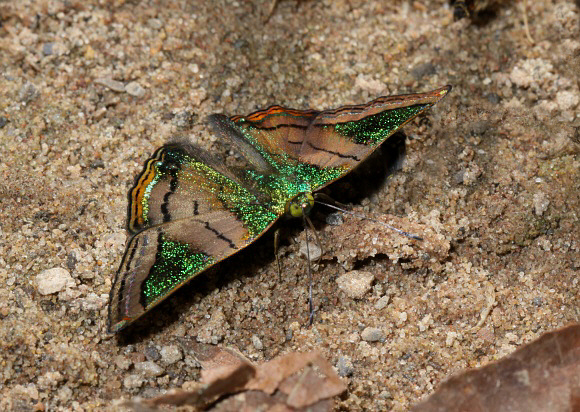 Caria fulvimargo, Satipo, Peru – Adrian Hoskins
Caria fulvimargo, Satipo, Peru – Adrian Hoskins
Introduction
The genus Caria contains some of the most beautiful and elusive species on Earth. Although fairly common they are rarely seen due to their secretive habits, and are virtually impossible to follow in flight. Once seen these glittering jewels of the Amazon are never forgotten.
Lepidopterists often feel quite overwhelmed by the beauty of these butterflies, but initial feelings of ecstasy are soon replaced by the rapid onset of frustration, anguish, despair and an uncontrollable urge to spend the next 2 hours searching relentlessly in the vicinity of the sighting, peering into bushes, crawling about on the ground and investigating every nook and cranny while muttering and pleading with the butterfly to reveal itself ! Unfortunately they have a habit of settling on mossy boulders or on algae covered ground, where they are superbly camouflaged.
There are about 14 species in the genus Caria, 5 of which are restricted to Central America, while the others including mantinea and sponsa are found primarily in Amazonia and the foothills of the eastern Andes.Several of the species including mantinea, plutargus, castalia and smaragdina are almost identical on the upperside. Theoretically they can be separated by examining the red markings at the base of the underside forewings. In mantinea there is a single large red blotch. In castalia and smaragdina the red markings on the underside are entirely absent. The underside markings of plutargus are similar to those of mantinea, but the median green band on the upperside is much broader than in either mantinea, castalia or smaragdina.
The illustrated taxon fulvimargo can be distinguished by the presence of thin orange borders on the underside hindwings, while the red markings at the base of its underside forewings are broken into 3 fragments. Lamas classifies fulvimargo as a subspecies of mantinea, but DNA analysis may well prove it to be a distinct species, as originally classified by Lathy.
The upperside and underside illustrations on this page depict the same individual.
 Caria fulvimargo, Satipo, Peru – Adrian Hoskins
Caria fulvimargo, Satipo, Peru – Adrian Hoskins
Habitats
This taxon appears to be confined to primary rainforest at altitudes between about 200-1000m.
Lifecycle
I have no data regarding fulvimargo but the lifecycle is probably very similar to that of other Caria species as follows: The eggs are laid singly under the leaves of Ulmaceae or Bromeliaceae. The caterpillars are densely hairy, and live and feed within rolled leaf tubes.
Adult behaviour
The adults probably spend much of their time in the canopy. Freshly emerged males descend on hot sunny mornings at which time they can sometimes be seen imbibing mineralised moisture from sandbanks, peccary wallows or pebble-strewn river beaches. They habitually settle between rocks or within crevices and are exceptionally difficult to locate. They have a rapid and erratic flight which is virtually impossible to follow with the eye.
The butterflies always bask in the characteristic posture illustrated in the photographs, with the forewings swept back, half covering the hindwings.
